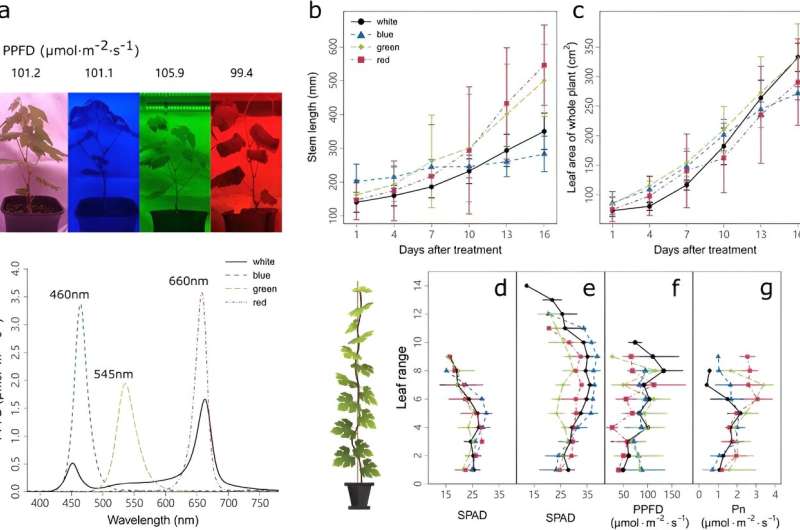This article has been reviewed according to Science X's editorial process and policies. Editors have highlighted the following attributes while ensuring the content's credibility:
fact-checked
peer-reviewed publication
proofread
Shedding light on grapevine growth: Unraveling the impact of LED light quality on photosynthesis and carbon metabolism

Grapevines, essential for wine and raisins, suffer losses due to poor establishment and decline of newly planted vines. Advances in manipulating nursery light spectra show promise for healthier vines, yet the exact mechanisms are unclear.
Research indicates that light quality, controlled via LED lighting technology, significantly impacts plant growth and photosynthesis, but responses vary among species and between different light wavelengths.
Comprehensive research, integrating physiological, biochemical, and transcriptomic analyses, is needed to understand how light quality affects grapevine growth and metabolism, particularly in uncovering the molecular basis of light's impact on photosynthesis and carbon dynamics.
In August 2023, Horticulture Research published a study titled "Grapevine plantlets respond to different monochromatic lights by tuning photosynthesis and carbon allocation."
The study revealed distinct responses of grapevine plantlets to different light qualities. Under green and red light, stem length increased similarly, whereas blue light showed no significant effect. On the other hand, the single- or whole-plant leaf area remained largely unchanged across different light qualities.
The spatial variation in leaf chlorophyll content (SPAD value) showed a typical pattern. Green light reduced the SPAD of leaves in most ranges and red light to a lesser extent, while blue light increased the SPAD for leaves in the middle canopy ranges.
Light quality also impacted the leaf blade's light intensity in a wavelength- and leaf-range-dependent manner. Particularly, blue and green light increased light intensity in the bottom ranges of leaves. Photosynthesis (Pn) differed among leaves in different canopy positions, with red light enhancing Pn in upper leaves.
Leaf gas exchange under different lights was studied using light response curves. Blue light significantly increased the maximum photosynthesis rate (Pnmax), especially at higher light intensities. In alignment with the increase in Pn, blue light also increased stomatal conductance and transpiration rate without affecting water use efficiency (WUE).
In contrast, green light reduced Pnmax, slightly decreased stomatal conductance, increased transpiration rate, and significantly reduced WUE. Red light had marginal effects on these parameters.
The distribution of dry matter and the major carbohydrate content in above- and underground was influenced by different light qualities. Blue light repressed excessive growth and significantly increased the leaf-specific weight by 38.29%. Red light increased the dry weight of the stem by 53.60%, the starch content of the leaf by 53.63%, and the sucrose content of the stem by 230%.
Whole genome transcriptome analysis revealed that different light qualities triggered specific genetic responses in leaves, stems, and roots. The expression patterns of genes related to photosynthesis, light signaling, and carbon metabolism varied significantly depending on the light quality. Notably, genes like VvCOP1, VvHY5, VvHYH and VvELIP may play important roles in this shoot-to-root signaling.
Furthermore, the correlation network analysis identified key genes associated with physiological traits like photosynthesis rate and specific leaf weight. For instance, genes like VvpsbS, VvHYH, and VvALDA1 showed strong correlations with these traits, indicating their potential role in light quality response and regulation of plant photosynthesis and carbon metabolism.
In conclusion, this study provides valuable insights into optimizing light recipes for grapevine growth, highlighting the distinct effects of different light qualities on plant growth, photosynthesis, carbon allocation, and genetic expression.
The findings underscore the complexity of plant responses to light and the potential of targeted light treatments to enhance grapevine growth and quality.
More information: Menglong Liu et al, Grapevine plantlets respond to different monochromatic lights by tuning photosynthesis and carbon allocation, Horticulture Research (2023). DOI: 10.1093/hr/uhad160
Journal information: Horticulture Research
Provided by Plant Phenomics





















